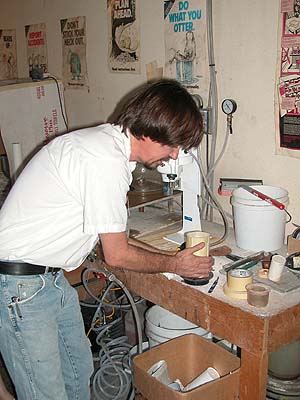Robert Casting Platinum
This is a quickie, the day the Kraft Masters were setting up Robert who is the plant manager at Precious Metals West casting platinum.
2 Minute Read
Robert Casting Platinum
This is a quickie, the day the Kraft Masters were setting up Robert who is the plant manager at Precious Metals West (PMT) cast a platinum ring he was working on.
Here is Daniel mixing plaster with a vacuum mixer and then using a bell dome and a vacuum to take the flask, plaster, wax model (inside) down to an airless state to remove air bubbles that might still be present in the wet plaster.
This is interesting for those of you that have never seen a centrifugal casting done before.
The casting is done by centrifugal force, it is basically the old-time way of casting and has been done for thousands of years.
This type of casting machine is driven by a spring which is wound up to the proper tension before the casting is done. It cannot be done when the molten metal and red hot plaster-filled flask are in the machine.
The flask containing the plaster mold, is placed in the casting machine when the wax model has been burned out of the plaster (leaving an exact copy of the jewelry piece behind in the plaster. This is done in a burn out oven and the temperatures typically get 1000 to 1600 F during this process.
Left - Robert has put the correct amount of platinum by weight into the centrifugal casting machine crucible and is heating it to a molten stage using a Hydrogen/Oxygen torch.
Note: A Hydrogen/Oxygen torch is a special type of torch that gets very hot very fast and burns cleaner than most other torches.
Casting using this technique does take some practice and experience to be successful at it.
The metal is heated to the proper temperature. This is where the experience comes in. If the metal is cast too cool the casting will often not come out completely. If the metal is cast too hot the metal can be porous, have pin holes and other problems.
Left - Robert has released the spring on the casting unit and the jewelry has been cast.
Note: The splash guard around the outside of the centrifugal caster is not just for show.
It is not unusual for pieces of hot metal to splash a little bit as the casting is initially done. The force of the spring casting is actually pretty strong and it spins fairly fast. Also, remember that the flask has a significant weight to it when it is filled with plaster and metal.
The weight of the flask and metal is counterbalanced by weights on the other end of the casting machine, in case you wondered.
Left - Robert has broken off most of the leftover plaster from the casting and you can see the ring and the stem (the channel where the molten metal entered the flask/casting.
The excess metal in the stem is just cut off of the casting and then saved to be melted down for later use in another casting project.
This is just a brief example of centrifugal casting, but you get the idea.
Jeff R. Graham
The late Jeff Graham was a prolific faceter, creator of many original faceting designs, and the author of several highly-regarded instructional faceting books such as Gram Faceting Designs.
Related Articles
Common Causes for Contaminated Laps
Finding Honest Experts
Tucson Gem Show 2005
What are Sintered Laps?
Latest Articles
800 Years of Mogok: A Celebration in Tenuous Times
What is the Average Gemstone Faceting Yield?
Pyroxmangite Value, Price, and Jewelry Information
How to Identify Emerald Simulants and Synthetics
Never Stop Learning
When you join the IGS community, you get trusted diamond & gemstone information when you need it.
Get Gemology Insights
Get started with the International Gem Society’s free guide to gemstone identification. Join our weekly newsletter & get a free copy of the Gem ID Checklist!
